
Guernica is a large 1937 oil painting by Spanish artist Pablo Picasso. It is one of his best-known works, regarded by many art critics as the most moving and powerful anti-war painting in history. It is exhibited in the Museo Reina Sofía in Madrid.

Les Demoiselles d'Avignon is a large oil painting created in 1907 by the Spanish artist Pablo Picasso.

Man at the Crossroads (1933) was a fresco by Mexican painter Diego Rivera. Originally slated to be installed in the lobby of the RCA Building at Rockefeller Center in New York City, the fresco showed aspects of contemporary social and scientific culture. As originally installed, it was a three-paneled artwork. A central panel, depicting a worker controlling machinery, flanked by two other panels, The Frontier of Ethical Evolution and The Frontier of Material Development, which respectively represented socialism and capitalism.

Picasso's African Period, which lasted from 1906 to 1909, was the period when Pablo Picasso painted in a style which was strongly influenced by African sculpture, particularly traditional African masks and art of ancient Egypt, in addition to non-African influences including Iberian sculpture, and the art of Paul Cézanne and El Greco. This proto-Cubist period following Picasso's Blue Period and Rose Period has also been called the Negro Period, or Black Period. Picasso collected and drew inspiration from African art during this period, but also for many years after it.
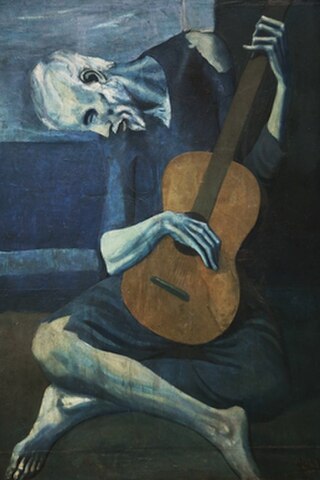
The Old Guitarist is an oil painting by Pablo Picasso, which he created in late 1903 and early 1904. It depicts an elderly musician, a haggard man with threadbare clothing, who is hunched over his guitar while playing in the streets of Barcelona, Spain. It is on display at the Art Institute of Chicago as part of the Helen Birch Bartlett Memorial Collection.

The Third of May 1808 is a painting completed in 1814 by the Spanish painter Francisco Goya, now in the Museo del Prado, Madrid. In the work, Goya sought to commemorate Spanish resistance to Napoleon's armies during the occupation of 1808 in the Peninsular War. Along with its companion piece of the same size, The Second of May 1808, it was commissioned by the provisional government of Spain at Goya's own suggestion shortly after the ousting of the French occupation and the restoration of King Ferdinand VII.

The Weeping Woman is a series of oil on canvas paintings by Pablo Picasso, the last of which was created in late 1937. The paintings depict Dora Maar, Picasso's mistress and muse. The Weeping Woman paintings were produced by Picasso in response to the bombing of Guernica in the Spanish Civil War and are closely associated with the iconography in his painting Guernica. Picasso was intrigued with the subject of the weeping woman, and revisited the theme numerous times that year. The last version, created on 26 October 1937, was the most elaborate of the series, and has been housed in the collection of the Tate Modern in London since 1987. Another Weeping Woman painting is housed at the National Gallery of Victoria and was involved in a high-profile political art theft.

La Lecture de la Lettre is an oil on canvas painting by Pablo Picasso, which he painted c. 1921, during his transition from Cubism to Neoclassicism, very close to the time of the birth of his son, Paulo. The painting depicts two well-dressed boys reading a letter. The boys have downcast expressions as they read. One boy has an oversized hand on the other's shoulder.
Icarus is a character in Greek Mythology who fell to his death when the sun melted the wax holding together the wings he was using to fly.
Minotauromachy is a 19.5 by 27.4” etching and engraving created by Spanish artist Pablo Picasso in Paris in 1935. The etching and resulting prints, literally entitled Minotaur Battle, feature many compositional aspects and themes seen often in Picasso’s art throughout the 1930s. These include the Minotaur, an unconscious or dying female matador on an injured horse, a young girl holding a candle and flowers, a man scaling a ladder, and two women watching with doves from a window. Created during a time of personal turmoil within which Picasso created little artwork, Minotauromachy stands out as a seminal and striking piece with no shortage of artistic interpretations.

Jeune garçon au cheval is an oil on canvas painting by Pablo Picasso. The painting is housed in the Museum of Modern Art in New York. It was painted in Picasso's Rose Period from 1905 to 1906, when he was still a struggling artist living in Paris. The painting is a study for a much larger composition that Picasso never completed.

Manuel Rodríguez Lozano was a Mexican painter, known for his “melancholy” depiction of Mexico rather than the more dominant political or festive one of the Mexican muralism movement. This is especially true of his “white stage” which is marked by cold colors and tragic scenes focusing on human figures which are skeletal or ghost-like. His work influenced Mexican films such as La perla.
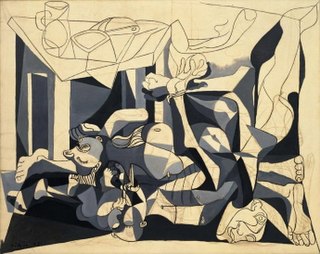
The Charnel House is an unfinished 1944–1945 oil and charcoal on canvas painting by Spanish artist Pablo Picasso, which is purported to deal with the Nazi genocide of the Holocaust. The black and white 'grisaille' composition centres on a massed pile of corpses and was based primarily upon film and photographs of a slaughtered family during the Spanish Civil War. It is considered to be the second of three major anti-war Picassos, preceded by Guernica in 1937 and succeeded by Massacre in Korea in 1951. The painting is housed in the Museum of Modern Art in New York City.

Family of Saltimbanques is a 1905 oil on canvas painting by Pablo Picasso. The work depicts six saltimbanques, a kind of itinerant circus performer, in a desolate landscape. It is considered the masterpiece of Picasso's Rose Period, sometimes called his circus period. The painting is housed in the collection of the National Gallery of Art in Washington, D.C.

Baigneuses, also called Bathers, is a Proto-Cubist painting, now lost or missing, created circa 1908 by the French artist and theorist Jean Metzinger. Possibly exhibited during the spring of 1908 at the Salon des Indépendants. This black-and-white image of Metzinger's painting, the only known photograph of the work, was reproduced in Gelett Burgess, "The Wild Men of Paris", Architectural Record, May 1910. The painting was also reproduced in The New York Times, 8 October 1911, in an article titled "The 'Cubists' Dominate Paris' Fall Salon", and subtitled, "Eccentric School of Painting Increases Its Vogue in the Current Art Exhibition - What Its Followers Attempt to Do".

The Fall of Phaeton is a painting by the Flemish master Peter Paul Rubens, featuring the ancient Greek myth of Phaeton (Phaethon), a recurring theme in visual arts. Rubens chose to depict the myth at the height of its action, with the thunderbolts hurled by Zeus to the right. The thunderbolts provide the light contrast to facilitate the display of horror on the faces of Phaeton, the horses and other figures while preserving the darkness of the event. The butterfly winged female figures represent the hours and seasons, who react in terror as the night and day cycle becomes disrupted. The great astrological circle that arches the heavens is also disrupted. The assemblage of bodies form a diagonal oval in the center, separating dark and light sides of the canvas. The bodies are arranged so as to assist the viewer's travel continually around that oval.
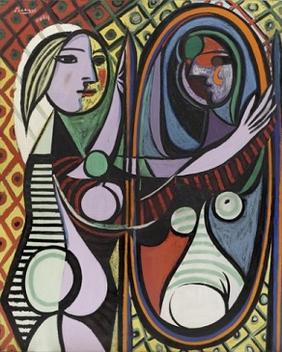
Girl before a Mirror(French: Jeune fille devant un miroir) is an oil on canvas painting by Pablo Picasso, which he created in 1932. The painting is a portrait of Picasso's mistress and muse, Marie-Thérèse Walter, who is depicted standing in front of a mirror looking at her reflection. It is housed in the collection of the Museum of Modern Art in New York City.

Au Lapin Agile is a 1905 oil on canvas painting by Pablo Picasso. It depicts the interior of the Lapin Agile, a famous cabaret club in the Montmartre area of Paris. The composition was produced during Picasso's Rose Period and includes a self-portrait of the artist who frequented the club in his youth. The painting is listed as one of the most expensive paintings after achieving a price of $40.7 million at Sotheby's auction on 27 November 1989. It is housed in the collection of the Metropolitan Museum of Art in New York City.
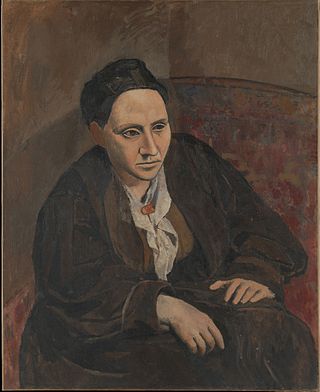
Portrait of Gertrude Stein is an oil-on-canvas painting of the American writer and art collector Gertrude Stein by Pablo Picasso, which was begun in 1905 and finished the following year. The painting is housed in the Metropolitan Museum of Art in New York. It is considered one of the important works of Picasso's Rose Period. The portrait has historical significance, due to the subject's role in Picasso's early life as a struggling artist and eventual commercial success. It also represents a significant transitional step in the artist's move towards Cubism.
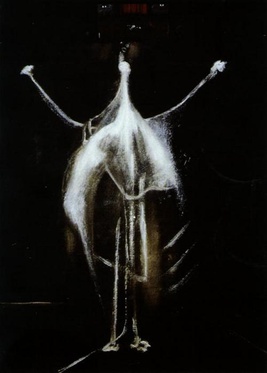
Crucifixion is an early oil-on-canvas painting by Francis Bacon, made in 1933 when Bacon was aged 23 or 24. It was one of three paintings on the subject of the Crucifixion that he made in 1933, the others being his Crucifixion with Skull, commissioned by art collector Sir Michael Sadler, and Wound for a Crucifixion. It is held in Damien Hirst's Murderme Collection.

















